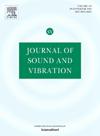Resonance and post-resonance backward whirl in intact and cracked rotor systems with rub-impact
IF 4.3
2区 工程技术
Q1 ACOUSTICS
引用次数: 0
Abstract
The whirling behavior in rotor systems is an indicator for rotor health monitoring. The abnormal whirling is the first sign for faults appearance in rotor systems. The excitation of backward whirling is associated with the shaft or bearing stiffness content. Nonsynchronous whirl near resonance speeds significantly affects rotor faults in rotor systems. The response of intact and cracked rotors in the presence of rotor-stator rubbing is significantly altered by the nonsynchronous whirling which further complicates the dynamical behavior of the rotor during its transient operation. In cracked rotors, the post-resonance backward whirl (Po-BW) excitation was proven to exist due to crack propagation and bearing anisotropy. Therefore, the influence of nonsynchronous whirl in association with rub-impact and breathing crack on the presence of Po-BW in intact and cracked rotor systems is numerically and experimentally investigated in the present research. The Jeffcott rotor and the finite element models are employed for numerical simulation during transient operation conditions. According to the obtained numerical and experimental whirl response results, the backward whirl phenomena can be now classified into three categories - pre-resonance, resonance and post-resonance backward whirls. Robust experimental evidence of the presence of Resonance-BW and Po-BW excitations in cracked and healthy rotor systems with rub-impact is analyzed which provides further insights on the effect of multiple faults on BW excitations.
含摩擦冲击的完整和裂纹转子系统的共振和后共振后旋涡
转子系统的旋转行为是转子健康监测的一个指标。异常旋转是转子系统出现故障的先兆。后向旋转的激励与轴或轴承的刚度含量有关。在转子系统中,共振转速附近的非同步旋转对转子故障有重要影响。完整转子和裂纹转子在动静摩擦作用下的响应会因非同步旋转而发生显著变化,这使得转子在瞬态运行过程中的动力学行为更加复杂。在裂纹转子中,由于裂纹扩展和轴承各向异性的影响,存在共振后的后向旋转激励(Po-BW)。因此,本文采用数值方法和实验方法研究了含摩擦碰撞和呼吸裂纹的非同步旋转对完整和裂纹转子系统中Po-BW存在的影响。采用Jeffcott转子和有限元模型对其瞬态工况进行了数值模拟。根据得到的旋流数值和实验结果,将后向旋流现象分为前共振、共振和后共振三类。分析了裂纹和健康转子系统存在共振-BW和Po-BW激励的鲁棒实验证据,从而进一步了解了多故障对BW激励的影响。
本文章由计算机程序翻译,如有差异,请以英文原文为准。
求助全文
约1分钟内获得全文
求助全文
来源期刊

Journal of Sound and Vibration
工程技术-工程:机械
CiteScore
9.10
自引率
10.60%
发文量
551
审稿时长
69 days
期刊介绍:
The Journal of Sound and Vibration (JSV) is an independent journal devoted to the prompt publication of original papers, both theoretical and experimental, that provide new information on any aspect of sound or vibration. There is an emphasis on fundamental work that has potential for practical application.
JSV was founded and operates on the premise that the subject of sound and vibration requires a journal that publishes papers of a high technical standard across the various subdisciplines, thus facilitating awareness of techniques and discoveries in one area that may be applicable in others.
 求助内容:
求助内容: 应助结果提醒方式:
应助结果提醒方式:


